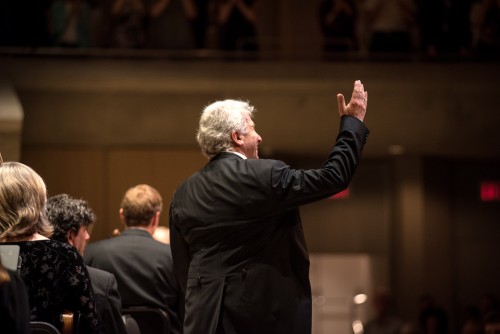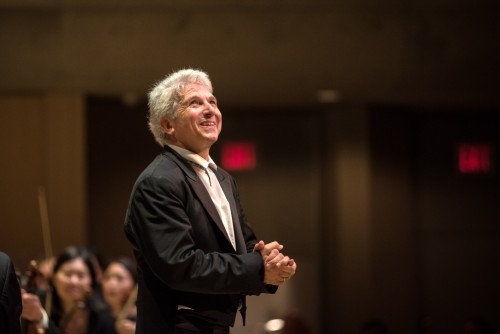 Peter Oundjian closed out his remarkable 14 years as TSO music director with five programs consisting of nine concerts spread over 18 days, June 13 to 30. From Mozart@ and New Creations to the Decades Project, Oundjian has been an innovative programmer who more often than not included stimulating content in what he offered audiences. I was fortunate to attend four of the five last programs (missing only Christopher Plummer’s Symphonic Shakespeare), and was particularly interested to hear Oundjian’s own rationale for why he programmed these last concerts the way he did.
Peter Oundjian closed out his remarkable 14 years as TSO music director with five programs consisting of nine concerts spread over 18 days, June 13 to 30. From Mozart@ and New Creations to the Decades Project, Oundjian has been an innovative programmer who more often than not included stimulating content in what he offered audiences. I was fortunate to attend four of the five last programs (missing only Christopher Plummer’s Symphonic Shakespeare), and was particularly interested to hear Oundjian’s own rationale for why he programmed these last concerts the way he did.
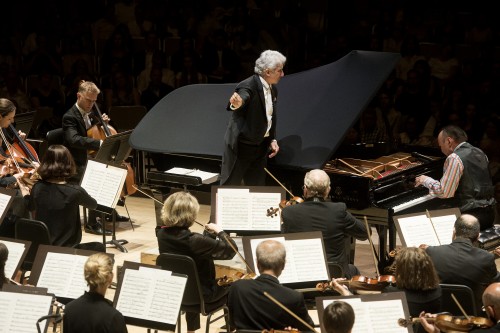 June 13. He introduced the June 13 evening by reminiscing about his arrival in New York City in 1975 – not quite 20-years-old – to attend Juilliard as a violinist, and getting a call from Leonard Bernstein to appear with him the next morning on the Today show. Hence the inclusion of Bernstein’s Three Dance Variations from Fancy Free, which the orchestra played with an appropriate rhythmic suppleness. Oundjian spoke about the music of George Gershwin being in the air in NYC in the 70s, typified by the lush score to Woody Allen’s Manhattan. Jon Kimura Parker proved to be a most worthy last-minute replacement for Jean-Yves Thibaudet in Gershwin’s Piano Concerto in F, very comfortable in the composer’s jazz-based idiomatic score. In an encore, Parker showed his jazz chops with a rousing performance of Oscar Peterson’s Blues Etude. An unexpected coincidence: Parker and Oundian graduated one after the other from Juilliard, with Oundjian getting his diploma ten seconds ahead of Parker thanks to the alphabet.
June 13. He introduced the June 13 evening by reminiscing about his arrival in New York City in 1975 – not quite 20-years-old – to attend Juilliard as a violinist, and getting a call from Leonard Bernstein to appear with him the next morning on the Today show. Hence the inclusion of Bernstein’s Three Dance Variations from Fancy Free, which the orchestra played with an appropriate rhythmic suppleness. Oundjian spoke about the music of George Gershwin being in the air in NYC in the 70s, typified by the lush score to Woody Allen’s Manhattan. Jon Kimura Parker proved to be a most worthy last-minute replacement for Jean-Yves Thibaudet in Gershwin’s Piano Concerto in F, very comfortable in the composer’s jazz-based idiomatic score. In an encore, Parker showed his jazz chops with a rousing performance of Oscar Peterson’s Blues Etude. An unexpected coincidence: Parker and Oundian graduated one after the other from Juilliard, with Oundjian getting his diploma ten seconds ahead of Parker thanks to the alphabet.
Later in Oundjian’s first year at Juilliard, Herbert von Karajan gave a masterclass, saving the last 20 minutes of it for the student orchestra’s “concertmeister” who was also studying conducting. Karajan stood three feet from Oundjian, and as if that weren’t intimidating enough, covered the score of the slow movement of Brahms’ First Symphony. “You know it, my boy,” he said. That same Brahms symphony completed Oundjian’s trip down memory lane, the French horn statement of the fourth-movement’s main theme reminding us of just how fresh the music of this repertoire standard can be.
June 16. After the focal dystonia that made his position as first violinist of the Tokyo String Quartet untenable, Oundjian accepted an invitation by conductor and pianist André Previn, a chamber music collaborator, to talk conducting in Previn’s home. Previn was artistic advisor to the Caramoor International Music Festival at the time and asked Oundjian to make his professional conducting debut at Caramoor’s 50th anniversary concert in July 1995. The first piece on that program was Glinka’s repertoire staple, the Overture to Ruslan and Lyudmila. Oundjian chose to open the June 16 TSO program with it – and the orchestra, just as they had done with the Brahms, infused it with new life.
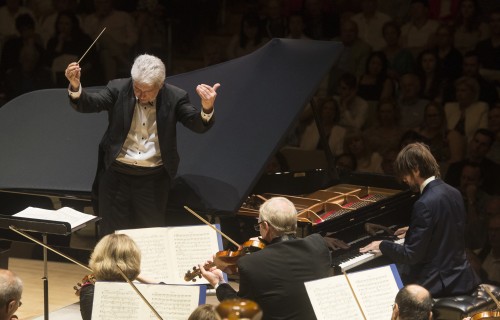 The first concert Oundjian attended in Carnegie Hall (also in that pivotal year, 1975) was Emil Gilels and Eugene Ormandy performing Rachmaninoff’s Piano Concerto No.3 in D Minor, Op.30. Who better than the dynamic young Russian pianist Daniil Trifonov to fly from Moscow to Toronto for two days, to perform the same work for this special occasion? Trifonov delivered a brilliant, sensitive interpretation, dashing off the technical challenges with ease and upping the audience’s satisfaction quotient with a relaxed version of the second movement of Prokofiev’s Piano Sonata No.8 as an encore. Completing the all-Russian program was a stunning performance of Ravel’s orchestration of Mussorgsky’s Pictures at an Exhibition, included because it was the first piece Oundjian ever recorded with the TSO. The TSO shone in this orchestral showpiece, with each section taking their lead from the trumpet’s opening Promenade as they rose to the occasion with dazzling playing throughout.
The first concert Oundjian attended in Carnegie Hall (also in that pivotal year, 1975) was Emil Gilels and Eugene Ormandy performing Rachmaninoff’s Piano Concerto No.3 in D Minor, Op.30. Who better than the dynamic young Russian pianist Daniil Trifonov to fly from Moscow to Toronto for two days, to perform the same work for this special occasion? Trifonov delivered a brilliant, sensitive interpretation, dashing off the technical challenges with ease and upping the audience’s satisfaction quotient with a relaxed version of the second movement of Prokofiev’s Piano Sonata No.8 as an encore. Completing the all-Russian program was a stunning performance of Ravel’s orchestration of Mussorgsky’s Pictures at an Exhibition, included because it was the first piece Oundjian ever recorded with the TSO. The TSO shone in this orchestral showpiece, with each section taking their lead from the trumpet’s opening Promenade as they rose to the occasion with dazzling playing throughout.
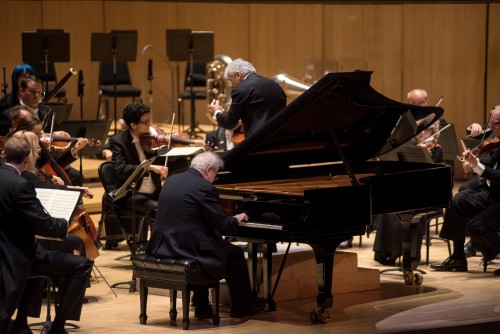 June 20. The evening of June 20 began with Emanuel Ax at the keyboard for Mozart’s Piano Concerto No.17 in G Major, K453. Oundjian said that Ax was the first soloist he accompanied with the TSO (in Chopin’s First Piano Concerto) and his presence on June 20 marked him as the final soloist of Oundjian’s time as music director. Ax played with a characterful solidity, a well-defined round, lovely, singing tone geared to the composer’s melodic sensibility. The orchestra was a balanced and transparent collaborator.
June 20. The evening of June 20 began with Emanuel Ax at the keyboard for Mozart’s Piano Concerto No.17 in G Major, K453. Oundjian said that Ax was the first soloist he accompanied with the TSO (in Chopin’s First Piano Concerto) and his presence on June 20 marked him as the final soloist of Oundjian’s time as music director. Ax played with a characterful solidity, a well-defined round, lovely, singing tone geared to the composer’s melodic sensibility. The orchestra was a balanced and transparent collaborator.
Mahler has long been a favourite of Oundjian and so he (appropriately) chose the Symphony No.9 in D Major to mark his departure. Oundjian set up the work by referring to the passion and tenderness of the opening movement, the parody of country life in the second (which Mahler asked to be played in a cumbersome way), and the third movement Burleske, which Oundjian saw as opening the door to the 20th century. The remarkable Adagio, “one of the most extraordinary experiences known to man,” lived up to Oundjian’s words given the TSO’s nakedly emotional, tender performance. The audience, rapt, waited close to a minute to break the spell with a standing ovation.
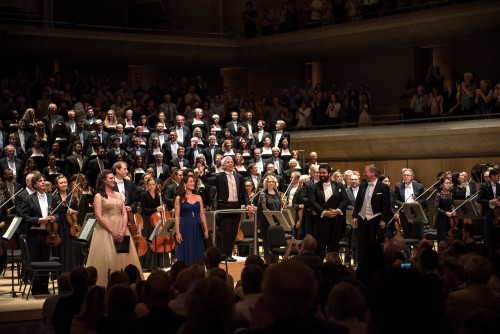 June 28-30. The conductor let the music speak for itself on June 28 (and reportedly on June 29 and 30 as well), and wisely so. These last three performances of Beethoven’s Symphony No.9 in D Minor, Op.125 “Choral” needed no words apart from those in its fourth movement. Is there any music more elevating, more soulful than the merger of the heavenly and the earthbound in its inspirational choral finale? Oundjian took a propulsive, no-nonsense approach to the work from its opening: doom, tension, release, tentativeness, foreboding, clarity, its intermittent roiling nature swept up by structural inexorability. The second movement’s rhythmic centrifugal force was delivered with the sensitivity of a chamber musician, while the wild and tuneful trio shimmered in the hands of the oboe and French horn. The Adagio molto e cantabile began with noble strings and horns setting up a graceful theme that moved from violas through violins, unhurriedly spoken by the woodwinds before the fateful announcement in the brass that led into the finale. Intimations of the Ode to Joy appeared before the baritone solo statement that heralded the participation of soprano, mezzo, tenor and the Toronto Mendelssohn Choir in the exultant beauty of a piece of music that stands the test of time.
June 28-30. The conductor let the music speak for itself on June 28 (and reportedly on June 29 and 30 as well), and wisely so. These last three performances of Beethoven’s Symphony No.9 in D Minor, Op.125 “Choral” needed no words apart from those in its fourth movement. Is there any music more elevating, more soulful than the merger of the heavenly and the earthbound in its inspirational choral finale? Oundjian took a propulsive, no-nonsense approach to the work from its opening: doom, tension, release, tentativeness, foreboding, clarity, its intermittent roiling nature swept up by structural inexorability. The second movement’s rhythmic centrifugal force was delivered with the sensitivity of a chamber musician, while the wild and tuneful trio shimmered in the hands of the oboe and French horn. The Adagio molto e cantabile began with noble strings and horns setting up a graceful theme that moved from violas through violins, unhurriedly spoken by the woodwinds before the fateful announcement in the brass that led into the finale. Intimations of the Ode to Joy appeared before the baritone solo statement that heralded the participation of soprano, mezzo, tenor and the Toronto Mendelssohn Choir in the exultant beauty of a piece of music that stands the test of time.
It was a fitting exit for the TSO’s new conductor emeritus.
Paul Ennis is the managing editor of The WholeNote.


